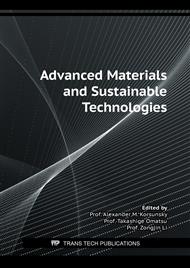[1]
B. Bakhtyar, T. Kacemi, M.A. Nawaz, A review on carbon emissions in Malaysian cement industry, Int. J. Energy Econ. Policy. 7 (2017) 282–286.
Google Scholar
[2]
A. Hasanbeigi, L. Price, E. Lin, Emerging energy-efficiency and CO2 emission-reduction technologies for cement and concrete production: A technical review, Renew. Sustain. Energy Rev. 16 (2012) 6220–6238. https://doi.org/10.1016/j.rser.2012.07.019.
DOI: 10.1016/j.rser.2012.07.019
Google Scholar
[3]
NSSGA, the Aggregates Industry Greenhouse Gases: Low Emissions, High Resiliency, (2021). https://www.nssga.org/sites/default/files/2021-05/NSSGAGreenhouseGasEmissionsReport04-26-21.pdf.
Google Scholar
[4]
J. Sjunnesson, Life Cycle Assessment of Concrete, Lund University, Lund, Sweden, (2005).
Google Scholar
[5]
N.S. Katsiotis, P.E. Tsakiridis, D. Velissariou, M.S. Katsiotis, S.M. Alhassan, M. Beazi, Utilization of Ferronickel Slag as Additive in Portland Cement: A Hydration Leaching Study, 6 (2015) 177–189. https://doi.org/10.1007/s12649-015-9346-7.
DOI: 10.1007/s12649-015-9346-7
Google Scholar
[6]
Z.A.H.M.S.N.M.K. Abed, Properties of reactive powder concrete containing different combinations of fly ash and metakaolin Volume, Mater. Today. 42 (2021) 2436–2440. https://doi.org/10.1016/j.matpr.2020.12.556.
DOI: 10.1016/j.matpr.2020.12.556
Google Scholar
[7]
W. Kushartomo, I. Bali, B. Sulaiman, Mechanical behavior of reactive powder concrete with glass powder substitute, Procedia Eng. 125 (2015) 617–622. https://doi.org/10.1016/j.proeng. 2015.11.082.
DOI: 10.1016/j.proeng.2015.11.082
Google Scholar
[8]
E.T. Dawood, M.H. Abdullah, Performance of green RPC containing nanoparticles and reinforced with hybrid fibers used for repairing damaged concrete, Case Stud. Constr. Mater. 13 (2020) e00428. https://doi.org/10.1016/j.cscm.2020.e00428.
DOI: 10.1016/j.cscm.2020.e00428
Google Scholar
[9]
T. Zdeb, An analysis of the steam curing and autoclaving process parameters for reactive powder concretes, Constr. Build. Mater. 131 (2017) 758–766. https://doi.org/10.1016/j.conbuildmat. 2016.11.026.
DOI: 10.1016/j.conbuildmat.2016.11.026
Google Scholar
[10]
R.S. Edwin, E. Gruyaert, N. De Belie, Influence of intensive vacuum mixing and heat treatment on compressive strength and microstructure of reactive powder concrete incorporating secondary copper slag as supplementary cementitious material, Constr. Build. Mater. 155 (2017) 400–412. https://doi.org/10.1016/j.conbuildmat.2017.08.036.
DOI: 10.1016/j.conbuildmat.2017.08.036
Google Scholar
[11]
R.S. Edwin, Magazine of Civil Engineering Effect of ferronickel slag in concrete and mortar, 109 (2022). https://doi.org/10.34910/MCE.109.9.
Google Scholar
[12]
EN-1015-3, Methods of test for mortar for masonry - Part 3: Determination consistence of fresh mortar (by flow table). CEN, Brussels, (2006).
DOI: 10.3403/01541440
Google Scholar
[13]
M. Helmi, M.R. Hall, L.A. Stevens, S.P. Rigby, Effects of high-pressure/temperature curing on reactive powder concrete microstructure formation, Constr. Build. Mater. 105 (2016) 554–562. https://doi.org/10.1016/j.conbuildmat.2015.12.147.
DOI: 10.1016/j.conbuildmat.2015.12.147
Google Scholar
[14]
A.K. Saha, P.K. Sarker, Sustainable use of ferronickel slag fine aggregate and fly ash in structural concrete : Mechanical properties and leaching study, J. Clean. Prod. 162 (2017) 438–448. https://doi.org/10.1016/j.jclepro.2017.06.035.
DOI: 10.1016/j.jclepro.2017.06.035
Google Scholar



